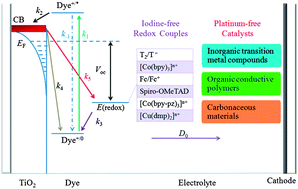Recent advances in alternative cathode materials for iodine-free dye-sensitized solar cells
Abstract
Over the last decades, iodine-free redox couples have been widely investigated as alternatives for the ubiquitous triiodide/iodide redox shuttle in

* Corresponding authors
a
State Key Laboratory of New Ceramics & Fine Processing, School of materials Science and Technology, Tsinghua University, Beijing 100084, P. R. China
E-mail:
hong-lin@tsinghua.edu.cn
b
Mechanical Engineering and Materials Science, Rice University, 6100 Main, Houston, Texas 77005, USA
E-mail:
jlou@rice.edu
c College of Materials Science and Chemical Engineering, Hainan University, Haikou 570228, P. R. China
Over the last decades, iodine-free redox couples have been widely investigated as alternatives for the ubiquitous triiodide/iodide redox shuttle in

 Please wait while we load your content...
Something went wrong. Try again?
Please wait while we load your content...
Something went wrong. Try again?
F. Hao, P. Dong, Q. Luo, J. Li, J. Lou and H. Lin, Energy Environ. Sci., 2013, 6, 2003 DOI: 10.1039/C3EE40296G
To request permission to reproduce material from this article, please go to the Copyright Clearance Center request page.
If you are an author contributing to an RSC publication, you do not need to request permission provided correct acknowledgement is given.
If you are the author of this article, you do not need to request permission to reproduce figures and diagrams provided correct acknowledgement is given. If you want to reproduce the whole article in a third-party publication (excluding your thesis/dissertation for which permission is not required) please go to the Copyright Clearance Center request page.
Read more about how to correctly acknowledge RSC content.
 Fetching data from CrossRef.
Fetching data from CrossRef.
This may take some time to load.
Loading related content
